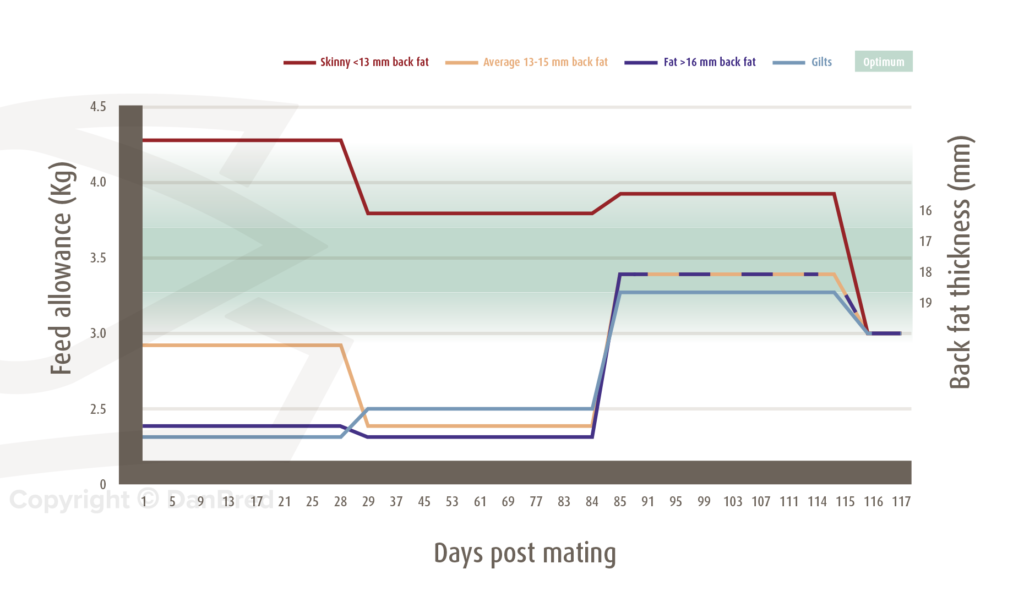Gestation – Keeping body condition in focus
Content
How to ensure balanced gestation feeding
Focusing on body condition throughout the gestation period has shown to be highly correlated to success in the farrowing unit and subsequent lifetime reproductive productivity.
Optimise production by focusing on body condition throughout gestation
DanBred breeding animals come with an extraordinary genetic potential for reproductive performance. Focusing on body condition throughout the gestation period has shown to be highly correlated to success in the farrowing unit and subsequent lifetime reproductive productivity.
Enhance performance at farrowing
Feeding during gestation serve 3 purposes:
- Successful conception and embryo implantation
- Ideal body condition for the lactation period
- Optimum uterine and maternal growth

The vast part of gestation feeding should be focused on restoring body condition from the previous lactation to ensure optimum lifetime productivity. The last 4 weeks of gestation feeding should be changed for optimised piglet birth weight as well as building and maintaining optimal body condition towards gestation (Van Heugten). Feeding sows according to body condition either individually or in groups by body condition will enhance performance at farrowing and optimise overall feed consumption (DPRC, 2013). It has been shown that feeding according to body condition and optimum back fat thickness (BFT) will significantly increase the number of live born piglets, optimise milk production and also reduces the risk of developing shoulder ulcers during lactation (Sørensen, 2010).
The recommended approach for feeding of DanBred breeding animals during gestation is to set 4 different feeding curves:
- Thin sows (BFT ≤ 11 mm)
- Average sows (BFT 12-14 mm)
- Fat sows (BFT >15 mm)
- Gilts

Each feed curve will ensure optimised nutritional balance in relation to the BFT as well as the time in gestation. By following DanBred’s ideal standards, the diet should keep an energy density of 9.5 MJ NE/12.5 MJ ME/1.05 EW and around 4.12 g Standardized Ileal Digestible (SID) per kg feed. The standards are based on the conditions in a temperate climate, however. temperature and humidity can have a big influence on feed consumption and should always be taken into consideration when formulating gestation feed. Feeding the full ration once per day will keep the sows full for longer and help to ensure a balanced behaviour among the sows (DPRC, 2013). Body condition and optimum BFT should remain in focus throughout gestation as this has a significant impact on the number of live born piglets as well as the base for optimised milk production.
Easy steps to reach the optimum weight at farrowing

Group the sows according to their body condition and follow their development throughout gestation.
At the time of farrowing the sows should have an average body condition with a BFT of 14-17 mm.
Follow and evaluate each sow to ensure correct adjustment of the feeding curve during gestation.
Evaluate at:
- Mating
- Post Pregnancy Detection
- 70 Days of Gestation
- 112 Days of Gestation
Recommended principles for feeding in gestation unit
The ideal diet should keep an energy density of 9.5 MJ NE/12.5 MJ ME/1.05 EW and around 4.12 g Standardized Ileal Digestible (SID) per kg feed.
After mating, it is recommended to keep a focus on the body condition of the sows, in particular the gilts in the first 4 weeks after mating where smaller gilts should be fed 2.2 kg/day, and bigger gilts should be fed 2.4 kg/day.
| Days post mating | Guideline feed allowance based on body condition score and BFT at mating (kg/day) | |||
| Fat > 15 mm | Average 12-14 mm | Skinny < 11 mm | Gilts | |
| 1-28 | 2.4 | 2.9 | 3.9 | 2.2 – 2.4 |
| 29-84 | 2.3 | 2.5 | 3.7 | 2.4 – 2.6 |
| 85-114 | 3.4 | 3.4 | 3.9 | 3.3 |
| 115-116 | 2.9 | 2.9 | 2.9 | 2.9 |
References
Danish Pig Research Centre (DPRC) (2013): Fordring af drægtige seør; SEGES Videncenter for Svineproduktion. Retrieved 14/02/19 https://svineproduktion.dk/viden/i-stalden/foder/udfodring/draegtige_soeer
Sørensen, G. (2010): Huldstyring af drægtige søer. Meddelelse nr. 862, Videncenter for Svineproduktion, Den rullende afprøvning.
Van Heugten, E.: Feeding Recommendations for Gestating Sows. Department of Animal Science, North Carolina State University Retrieved: 14/02/19 https://projects.ncsu.edu/project/swine_extension/ publications/factsheets/810s.htm.
Walker, B.; Young, B.A. (1992): Modelling the development of uterine components and sow body composition in response to nutrient intake during pregnancy. Livestock Production Science. 30: 3: 251-264




